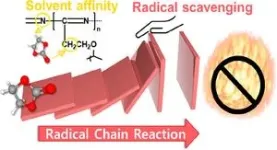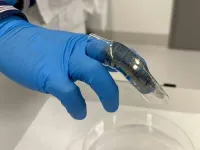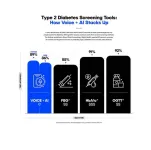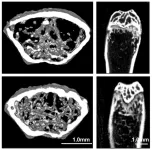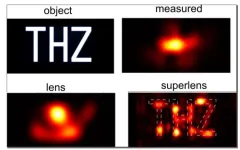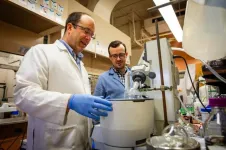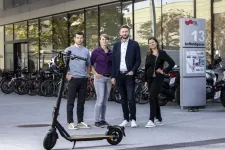(Press-News.org) A collaborative research team, led by Professor Hyun-Kon Song in the School of Energy and Chemical Engineering at UNIST, Dr. Seo-Hyun Jung from Research Center for Advanced Specialty Chemicals at Korea Research Institute of Chemical Technology (KRICT), and Dr. Tae-Hee Kim from the Ulsan Advanced Energy Technology R&D Center at Korea Institute of Energy Research (KIER), has achieved a groundbreaking milestone in battery technology. Their remarkable achievement in developing a non-flammable gel polymer electrolyte (GPE) is set to revolutionize the safety of lithium-ion batteries (LIBs) by mitigating the risks of thermal runaway and fire incidents.
In the past, the potential flammability of LIBs has raised significant concerns, especially in electric vehicles, where fire hazards pose a serious threat to underground parking lots. Addressing this critical issue, the research team has successfully developed a groundbreaking non-flammable polymer semi-solid electrolyte, offering a promising solution to mitigate battery fires.
Conventionally, non-flammable electrolytes have heavily relied on the incorporation of flame retardant additives or solvents with exceptionally high boiling points. However, these methods often resulted in a considerable decrease in ion conductivity, compromising the overall performance of the electrolyte.
In their breakthrough research, the research team introduced a trace amount of polymer into the electrolyte, creating a semi-solid electrolyte. This novel approach dramatically increased the lithium ion conductivity by 33% compared to existing liquid electrolytes. Moreover, the pouch-type batteries incorporating this non-flammable semi-solid electrolyte exhibited a remarkable 110% improvement in life characteristics, effectively preventing unnecessary electrolyte reactions during the formation and operation of the solid-electrolyte interphase (SEI) layer.
The key advantage of this innovative electrolyte lies in its exceptional performance and non-combustibility. By suppressing radical chain reactions with fuel compounds during the combustion process, the polymer semi-solid electrolyte effectively inhibits the occurrence of battery fires. The research team demonstrated the excellence of the developed polymer by quantitatively analyzing its ability to stabilize and suppress radicals.
Jihong Jeong (School of Energy and Chemical Engineering, UNIST) emphasized, “The interaction between the polymerized material inside the battery and volatile solvents allows us to effectively suppress radical chain reactions. Through electrochemical quantification, this breakthrough will greatly contribute to understanding the mechanism of non-flammable electrolytes.”
Co-first author Mideum Kim, a master student in the School of Energy and Chemical Engineering at UNIST and the Korea Research Institute of Chemical Technology (KRICT), further confirmed the exceptional safety of the battery itself through various experiments. The team’s comprehensive approach included applying the non-flammable semi-solid electrolyte to pouch-type batteries, ensuring the evaluation of electrolyte non-combustibility extended to practical battery applications.
“The research team’s multidisciplinary composition, involving electrochemistry from UNIST, polymer synthesis from the KRICT Research Center for Advanced Specialty Chemicals, and battery safety testing by the Ulsan Advanced Energy Technology R&D Center at Korea Institute of Energy Research (KIER), has been instrumental in achieving this breakthrough,” stated Professor Song. “The use of non-flammable semi-solid electrolytes, which can be directly incorporated into existing battery assembly processes, will accelerate the future commercialization of safer batteries.”
The research study has applied for five patents in Korea and two overseas, further highlighting the significance of this achievement. Additionally, it has been selected as a supplementary cover for ACS Energy Letters, with publication online on October 13, 2023. This study has been made possible through the support of the National Research Foundation of Korea (NRF), the Ministry of Science and ICT (MSIT), the Korea Evaluation Institute of Industrial Technology (KEIT), the Korea Research Institute of Chemical Technology, and Samsung SDI Co., Ltd.
Journal Reference
Jihong Jeong, Mideum Kim, Hyeju Shin, et al., “Fire-Inhibiting Nonflammable Gel Polymer Electrolyte for Lithium-Ion Batteries,” ACS Energy Lett., (2023).
END
Researchers unveil fire-inhibiting nonflammable gel polymer electrolyte for lithium-ion batteries
2023-10-18
ELSE PRESS RELEASES FROM THIS DATE:
Test of police implicit bias training shows modest improvements
2023-10-18
SPOKANE, Wash. – A two-part training designed to help police officers recognize their implicit bias, revealed some behavior improvement and lowered citizen discrimination complaints in a controlled study. While a small study involving one police department, it is the first-known research to provide evidence that this type of training can produce positive behavioral effects.
Led by Washington State University researcher Lois James, the study found some improvement in the anti-bias trained officers’ behavior toward homeless people in particular, ...
Wearable device makes memories and powers up with the flex of a finger
2023-10-18
Researchers have invented an experimental wearable device that generates power from a user’s bending finger and can create and store memories, in a promising step towards health monitoring and other technologies.
The innovation features a single nanomaterial incorporated into a stretchable casing fitted to a person’s finger. The nanomaterial enabled the device to generate power with the user bending their finger.
The super-thin material also allows the device to perform memory tasks, as outlined below.
Multifunctional devices normally require several materials in layers, which involves the time-consuming challenge of stacking nanomaterials with high precision.
The team, led ...
AI and 10 seconds of voice can screen for diabetes, new study reveals
2023-10-18
Determining whether a person is diabetic could be as easy as having them speak a few sentences into their smartphone, according to a groundbreaking study from Klick Labs that combines voice technology with artificial intelligence in a major step forward in diabetes detection.
The new study, published in Mayo Clinic Proceedings: Digital Health, outlines how scientists used six to 10 seconds of people’s voice, along with basic health data, including age, sex, height, and weight, to create an AI model ...
AI identifies antimalarial drug as possible osteoporosis treatment
2023-10-18
Correction (Oct. 17, 2023): The paper’s title has been corrected to “Deep Learning-Predicted Dihydroartemisinin Rescues Osteoporosis by Maintaining Mesenchymal Stem Cell Stemness through Activating Histone 3 Lys 9 Acetylation
Artificial intelligence has exploded in popularity and is being harnessed by some scientists to predict which molecules could treat illnesses, or to quickly screen existing medicines for new applications. Researchers reporting in ACS Central Science have used one such deep learning algorithm, and found that dihydroartemisinin ...
Simplifying the generation of three-dimensional holographic displays
2023-10-18
Holograms that offer a three-dimensional (3D) view of objects provide a level of detail that is unattainable by regular two-dimensional (2D) images. Due to their ability to offer a realistic and immersive experience of 3D objects, holograms hold enormous potential for use in various fields, including medical imaging, manufacturing, and virtual reality. Holograms are traditionally constructed by recording the three-dimensional data of an object and the interactions of light with the object. However, this technique is computationally highly intensive as it requires ...
Superlensing without a super lens: physicists boost microscopes beyond limits
2023-10-18
Ever since Antonie van Leeuwenhoek discovered the world of bacteria through a microscope in the late seventeenth century, humans have tried to look deeper into the world of the infinitesimally small.
There are, however, physical limits to how closely we can examine an object using traditional optical methods. This is known as the ‘diffraction limit’ and is determined by the fact that light manifests as a wave. It means a focused image can never be smaller than half the wavelength of light used to observe an object.
Attempts to break this limit with “super lenses” have all hit the hurdle of extreme visual losses, making the lenses opaque. ...
Collaborative study focuses on using computer algorithms to find molecular adaptations to improve COVID-19 drugs
2023-10-18
As the COVID-19 pandemic scattered and isolated people, researchers across Virginia Tech connected for a data-driven collaboration seeking improved drugs to fight the disease and potentially many other illnesses.
A multidisciplinary collaboration spanning several colleges at Virginia Tech resulted in a newly published study, “Data Driven Computational Design and Experimental Validation of Drugs for Accelerated Mitigation of Pandemic-like Scenarios,” in the Journal of Physical Chemistry Letters.
The study focuses on using computer algorithms to generate adaptations to ...
Study predicts potential for 110% electricity increases in U.S. urban buildings
2023-10-18
A research study led by University of Oklahoma assistant professor Chenghao Wang and recently published in the journal Nature Communications tackled the critical issue of how city-scale building energy consumption in urban environments will evolve under the influence of climate change.
Fossil fuels account for approximately 40% of all building energy use in urban city centers in the United States, and the U.S. Energy Information Administration reports that residential and commercial buildings in U.S. cities are one of the major energy ...
Open access: Need to move away from transformative agreements
2023-10-18
Sweden is far ahead when it comes to promoting open access to scholarly publications. But there is risk of getting stuck in a permanent transformation that favours large commercial publishers. A new report from the Association of Swedish Higher Education Institutions develops a strategy on how to work in negotiations with the publishers.
In 2021, the Association of Swedish Higher Education Institutions (Sveriges universitets- och högskoleförbund, SUHF) convened a “Beyond transformative agreements” working group (the BTA group) to lay the foundation for further advancing the transition to open access. Now, the group ...
Graz University of Technology study on e-scooter accidents: more helmets and less speed reduce the injury risk
2023-10-18
The use of e-scooters has increased significantly in recent years, but so has the number of accidents involving this relatively new form of transport. At the same time, knowledge about injury mechanisms in this area was still very limited. In the project SURF, funded by Zukunftsfonds Steiermark, the Vehicle Safety Institute at Graz University of Technology (TU Graz) investigated this topic using Human Body Models and derived recommendations to reduce the injury risk in e-scooter accidents.
Put on a helmet, decrease speed and get off the pavement
As ...

